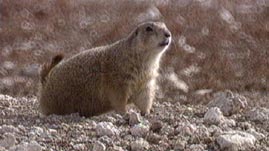Teachers' Domain - Digital Media for the Classroom and Professional Development
User: Preview

Source: Texas Parks and Wildlife Department
Biologists have recently begun to understand how prairie dog colonies benefit their native habitat. This video from Texas Parks and Wildlife Department describes the prairie dog and its grassland ecosystem, explains its role in creating species diversity, and considers how we can apply this knowledge in protecting the colonies that remain.
Don't be fooled. The unassuming prairie dog, with its panicked warning call and inclination to dive underground at the slightest hint of danger, is no pushover. Consider the facts: the prairie dog has been beleaguered, pushed out, or pursued for more than a century by ranchers and housing developers; its numbers have dropped by 98 percent in little more than a century; and it has been subjected to one of the most thorough habitat destruction movements in history, resulting in the loss of a great many plant and animal species. Yet the prairie dog continues to burrow, breed, and make its living in small pockets of the North American Great Plains. Now, as biologists recognize the prairie dog's importance to the native prairie ecosystem, some protections have been put in place to challenge their continued extermination.
The prairie dog's decline has been largely a result of European settlers' widespread push of progress across the Great Plains. The burrowing rodents, members of the squirrel family, simply stood in the way of a booming agricultural industry and the cities and towns that accompanied it. In 1900, an estimated five billion prairie dogs occupied colonies on the surface of and beneath the grasslands of North America. A century later, only isolated pockets remain, yet they continue to be shot and poisoned, particularly by ranchers who are certain that prairie dogs compete with cattle for food and that their burrows pose a risk to the legs of livestock.
Regardless of the justification for prairie dog extermination, we now know that the rodents provide benefits critical to the health of the prairie ecosystem. First, an active prairie dog colony provides an abundant and stable food source for predators such as coyotes, foxes, hawks, eagles, ferrets, and badgers. While these animals prey heavily on prairie dogs, they also help to control populations of other rodents, such as mice and rats.
In addition, prairie dogs create burrows that protect a wide variety of creatures, including burrowing owls, snakes, salamanders, ferrets, badgers, and many types of insects. The burrows also help to aerate the prairie soil and distribute nutrients, making the ecosystem more productive.
Biologists estimate that a single healthy prairie dog colony may benefit as many as 170 different vertebrate species. Prairie dog colonies are clearly a vital part of their native ecosystem—a fact that should be weighed carefully against any desire to exterminate this important species.
 Loading Standards
Loading Standards Teachers' Domain is proud to be a Pathways portal to the National Science Digital Library.
Teachers' Domain is proud to be a Pathways portal to the National Science Digital Library.
